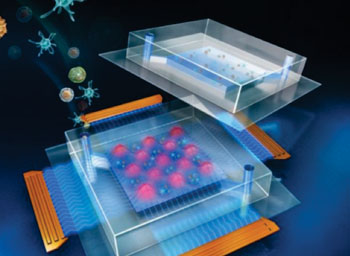Microfluidic Disposable Device Diagnoses Diseases Cheaply
By LabMedica International staff writers
Posted on 16 Dec 2015
The development of a reusable microfluidic device for sorting and manipulating cells and other micro/nano meter scale objects will make biomedical diagnosis of diseases cheaper and more convenient in regions where medical facilities are sparse or cost is prohibitive.Posted on 16 Dec 2015
Both bulk acoustic wave (BAW) and surface acoustic wave (SAW) based approaches have shown their competency in the manipulation of macro- to nano- scale objects, regardless of an object's optical or electrical properties. A wide range of applications in static or continuous flow such as manipulating cells, moving organisms have been demonstrated by either BAW or SAW tweezers.

Image: Schematics of the reusable acoustic tweezers device (bottom) with a disposable microfluidic laboratory for cell manipulation and disease diagnosis (Photo courtesy of Penn State University).
Scientists at the Penn State University (University Park, PA, USA) developed reusable acoustic tweezers to realize acoustic manipulation of cells or particles with a SAW platform and disposable superstrate devices. They locally transmitted standing surface acoustic waves into a removable, independent polydimethylsiloxane (PDMS)-glass hybridized microfluidic superstrate device for micromanipulation. By configuring and regulating the displacement nodes on a piezoelectric substrate, cells and particles were effectively patterned and transported into the superstrate.
The label-free and contactless nature of acoustic waves could offer a simple, accurate, low-cost, biocompatible, and disposable method for applications in the fields of point-of-care diagnostics and fundamental biomedical studies. In addition to its use in diagnosing diseases such as human immunodeficiency virus (HIV) and tuberculosis, both of which are endemic in resource-poor regions of the world, the device should find widespread use in hospitals, clinics, biology laboratories and the home due to its low cost and ease of use.
Tony Jun Huang, PhD, a professor and lead author of the study, said, “We believe our acoustic tweezers have tremendous potential, especially in diagnostics, with some applications also in therapeutics. Our current device works well, but to be used in diagnostics, the whole device has to be disposed of after one use. We have now found a way to separate the fluid-containing part of the device from the much more expensive ultrasound-producing piezoelectric substrate. This makes disposable acoustic tweezers possible.” The study was published on October 28, 2015, in the journal Lab on a Chip.
Related Links:
Penn State University













